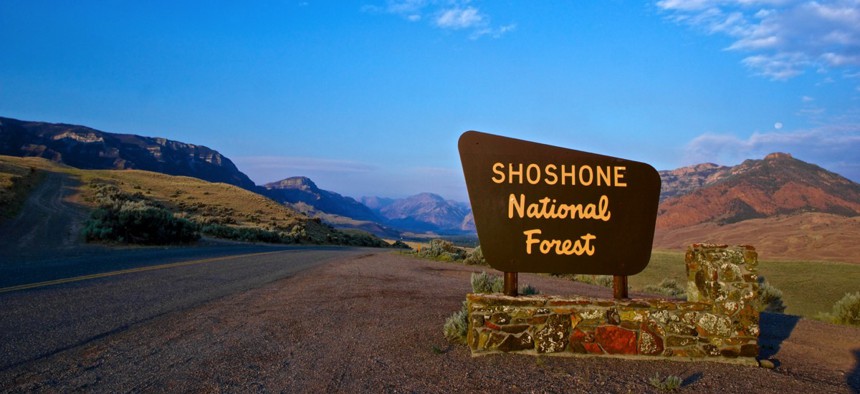Why Some Governors Are Annoyed By Federal Land-Use Policies

The Shoshone National Forest in Wyoming. kenkistler / Sutterstock.com
“Rather than shutting coal down,” Wyoming Gov. Matt Mead said, “let’s find solutions to make it better.”
WASHINGTON — As they met with Interior Secretary Sally Jewell here on Saturday, governors from the western U.S. took the view that their states should get more leeway from the federal government when it comes to public land management and energy industry regulation.
Jewell joined a group of about ten governors from around the country who sit on the National Governors Association’s Natural Resources Committee. The association held its winter gathering in the nation’s capital over the weekend.
During the committee session, a wide variety of topics were touched upon, such as wildfires, the flaring of natural gas, the Endangered Species Act, and national parks. Overall it was a cordial affair, with the governors on the panel praising the secretary for her accessibility. And while long-standing tensions over public lands and energy resources did percolate throughout the session, they never came close to boiling over.
That said, governors hailing from western states did take the opportunity to voice concerns they have with federal policy.
“What traditionally, kind of, comes out of Washington, D.C. is a one-size-fits-all approach. We’d like to be sure, as we have these discussions, that there’s a recognition of the differences of the states and the regions,” said Utah Gov. Gary Herbert, a Republican who is also the current chairman of the National Governors Association. “All states are not the same.”
Herbert said there had been bipartisan frustration in his state over the federal management of public lands, including with issues tied to wildfire prevention, ranching and development. “We have wild horses and burros that roam the grazing land we can’t control,” he said. “We have industry and commercialization that should be able to take place in some places.”
Some of the laws and regulations crafted in the nation’s capital, Herbert believes, are well meaning, but “lack common sense.”
Even so, he told Jewell: “Thanks for listening. I think you’ve done a good job.”
In her remarks, the Interior secretary stressed the importance of public lands. “They belong to all Americans,” she said. “But they also are oftentimes a source of conflict.”
At one point, she referenced the recent, 41-day standoff that ended earlier this month at the Malheur National Wildlife Refuge in southeastern Oregon. A central tenet for the armed group that seized the refuge was the idea that the federal government should relinquish control over public lands.
“The people that occupied that refuge did not have local support,” Jewell said. “The people from that region said: ‘We have a good relationship with the federal government.’”
The Natural Resources Committee’s chairman is Wyoming Gov. Matt Mead, who is a Republican.
Wyoming is the nation’s top coal-producing state.
The Obama administration announced last month that no new federal leases to mine coal on public land would be issued while the program they are offered through undergoes a review.
Mead did not vocally attack the administration over that move during the meeting. But he did tout the state’s mining, natural gas and oil sectors, saying that “the energy Wyoming produces is indispensable.”
“We are proud that we are an energy state,” Mead added. “But we recognize that many have concerns about climate change and the effect that coal has on climate change.” He noted that the state was exploring new technology that might allow the continued use of coal, while reducing pollution. “Rather than shutting coal down,” Mead said. “Let’s find solutions to make it better.”
Jewell said she believed there were pathways toward developing U.S. energy resources and protecting the environment. Looking to the future is key, she said, whether that means cleaner coal technology, or shifting the nation further toward renewable sources of energy.
“We do have a moral responsibility, as leaders in this country, to manage our energy resources not just for this generation, but for the next generation, too,” Jewell added.
Governors on the natural resources committee from eastern states spoke out as well.
Connecticut Gov. Dannel P. Malloy, a Democrat, gave a full-throated endorsement of the work the Interior Department was doing to protect the environment.
Referring to his state, he said the “only truly large natural resource we have is air.”
“We are down the pipe from states that burn lots of coal to generate their electric energy,” Malloy said. While he acknowledged coal was important to other state economies, Malloy emphasized that it “does not come without a price,” and “it is a great burden on the people of Connecticut.”
Gov. Bill Walker, of Alaska, pointed out that 65 percent—about 54.6 million acres—of America’s national park system falls within in his state.
“If somebody’s short a park,” he said, “we can help you out with that.”
Alaska’s state budget, which has been heavily reliant on revenues from the oil industry for decades, is currently facing a roughly $3.5 billion deficit. Driving this shortfall are steep declines in oil production in the state’s North Slope region, and low crude oil prices. Walker, elected as an Independent, has clashed with the Obama administration over which lands in Alaska should be open to oil drilling.
“Our economy is becoming an endangered species,” the governor quipped on Saturday. Referring to the federal government, he then added: “We want to continue to work with you, since you are basically our landlord.”
Jewell responded by saying her department would look for ways to assist Alaska. “You’ve got a tough situation,” she said. But the secretary also made clear that one position remained unchanged: “Not drilling in the Arctic National Wildlife Refuge.”
Earlier in the meeting, Walker told Jewell: “I’ve never met with somebody so often, who I agreed with so little.” But then he added: “That’s a compliment to you.”
Bill Lucia is a Reporter for Government Executive’s Route Fifty.
NEXT STORY: Prosecutors’ Perspective on Police Body-Worn Cameras






